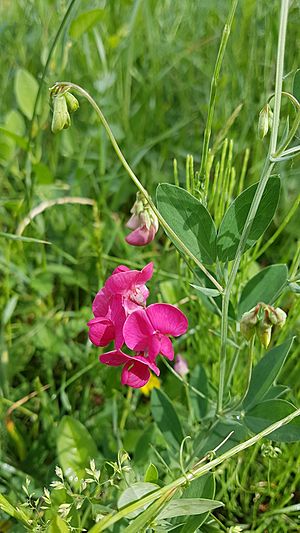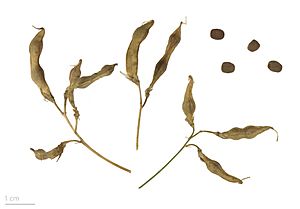Lathyrus tuberosus facts for kids
Quick facts for kids Lathyrus tuberosus |
|
|---|---|
 |
|
| Flowers, flower buds, and leaves of Lathyrus tuberosus | |
| Scientific classification | |
| Genus: |
Lathyrus
|
| Species: |
tuberosus
|
The Lathyrus tuberosus is a cool plant also known as the tuberous pea or earthnut pea. It's a small plant that climbs like a vine. This plant lives for many years, so it's called a perennial. You can find it naturally in wet, mild parts of Europe and Western Asia.
This plant can grow up to about 1.2 meters (4 feet) tall. It uses special curly parts called tendrils to help it climb. Its leaves have two small parts and a climbing tendril at the end.
Contents
What it Looks Like
The Lathyrus tuberosus is a plant that comes back every year. It has special edible tubers (like small potatoes) on its roots. These tubers are usually about 3 to 5 centimeters long. The plant's stem grows to be about 30 to 80 centimeters tall. It spreads out and is mostly smooth.
Its leaves grow one after another along the stem. They have short stalks and small, narrow parts called stipules. Each leaf has two wide, pointed leaflets and a tendril at the very end. The plant's flowers grow in a cluster on a long stem. There are usually two to seven pinkish-red flowers. Each flower is about 12 to 20 millimeters long. They have five sepals and five petals. The flowers are shaped a bit unevenly.
After the flowers, flat brown pods grow. Each pod can hold up to six seeds. The tubers of this plant are found about 14 centimeters deep in the soil. Its roots can go down quite far, up to 70 centimeters. This plant usually blooms in July and August.
Life Cycle and Reproduction
The Lathyrus tuberosus plant can make more of itself in two ways. It can grow new plants from its tubers, or it can grow from seeds. Its flowers have both male and female parts. Bees help to pollinate the flowers.
Sometimes, the seed pods of the Lathyrus tuberosus don't have many good seeds. Also, tiny beetles and wasps can sometimes get into the seeds. It's hard for the seeds to sprout on their own. But if you scratch the seed coat a little, they sprout much better. Once a seed sprouts, the plant grows very fast. It can even make seed pods and small tubers in its first year.
The tubers on the plant's roots can grow new stems and roots. This means a new plant can start from a tuber. You can also split the tubers to grow new plants. This works best in autumn when the plant is resting. Growing new plants from tubers is very successful. Growing from seeds helps the plant get new genetic mixes. This can help it live in different places.
This plant has 14 chromosomes. These are like tiny instruction books inside the plant's cells. Different Lathyrus tuberosus plants can have different amounts of a special material called heterochromatin in their chromosomes.
As the seeds grow, special protein storage parts form inside them. All the cells in the baby plant (embryo) help store these proteins. Scientists think that increasing the number of chromosomes in the plant could help it store even more protein in its seeds.
Where it Grows
The Lathyrus tuberosus first came from West Asia and Eastern Europe. People think it spread across middle Europe when farming started. It was brought to North America and can even be found in North Africa. However, today it is an endangered species in Switzerland and Austria.
This plant usually grows in grassy areas, along the edges of forests, in hedges, and on banks. It likes soils that are alkaline, rich in calcium, and have a good amount of fine dirt. But it can also grow on stony ground. In warmer, drier places, it needs moisture close to the surface of the soil. This is because of how its roots are shaped. The Lathyrus tuberosus can grow in places as high as 1600 meters (about 5,250 feet) above sea level.
How People Use It
Today, some people in middle Europe grow Lathyrus tuberosus in their gardens. They like its smell, its pretty look, and its edible tubers. In the 1500s, people used the flowers to make perfume. In the 1700s, it was grown on a larger scale in parts of Germany and the Netherlands. After harvesting, the tubers were cooked or roasted for people to eat. At that time, this root vegetable, which had a "gentle nutty flavor," was popular in French markets.
Sometimes, the tubers were used to make fermented drinks or bread. Oil was also pressed from the seeds. In the 1900s, there were promising tests to use Lathyrus tuberosus as food for farm animals. Recent studies from Turkey show that some people in the countryside still eat the above-ground parts of Lathyrus tuberosus as a wild plant.
Lathyrus tuberosus can grow well in soils where other crops struggle. This is because it can handle many different conditions. It has even been found to grow well in very salty soil. Plants that could handle more salt even had better photosynthesis. This plant does not like too much ammonium nitrate fertilizer.
Even though it tastes good and is healthy, Lathyrus tuberosus doesn't produce a lot of tubers. It needs to grow for two or three years to make tubers of a good size. In 1968, people tried to get more tubers by using better farming methods and hybridization. This test showed that the plant has a lot of potential for breeding. They were able to increase the tuber yield by six times!
The plant is pretty, but slugs like to eat it. In Ontario, Canada, it is considered a harmful weed. Some weed killers sold in Europe are designed to target Lathyrus tuberosus.
What's Inside: Nutrition
Many people say the tubers of Lathyrus tuberosus taste delicious. The tubers contain about 16-20% starch, 5% sugar, and 10-12% protein. The proteins are made of important building blocks called amino acids.
The green parts of the plant have a lot of Vitamin C. They can have about 161.25 milligrams of Vitamin C per 100 grams. That's about twice as much as the daily amount you need. It's also three times more than the Vitamin C in lemons! The amount of calcium in the plant is almost twice as much as in cow's milk.
Some wild types of this plant have a substance that can be harmful if eaten in very large amounts. This is mostly a concern for animals.
| Minerals | Amount (mg/100g) |
|---|---|
| Phosphorus | 66 |
| Potassium | 1544 |
| Magnesium | 43 |
| Calcium | 228 |
| Sodium | 2 |
| Iron | 2.5 |
| Zinc | 0.6 |
| Manganese | 0.78 |
| Copper | 0.07 |
Helping Nature
The Lathyrus tuberosus is a plant that can be used for many things. Its leaves and tubers are good to eat and full of vitamins. It belongs to the legume family of plants. These plants are special because they can take nitrogen from the air and put it into the soil. This helps make the soil healthier and more fertile. Also, its flowers are pollinated by bees, which is good for the environment.
Because of these features, Lathyrus tuberosus can help increase the variety of plants and animals in farm areas. Since it takes several years for the tubers to grow big, this plant would be great for permaculture. Permaculture is a way of farming that works with nature to create lasting and healthy systems.



